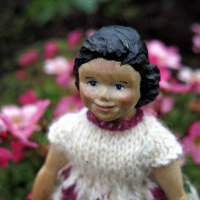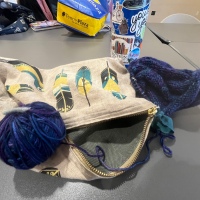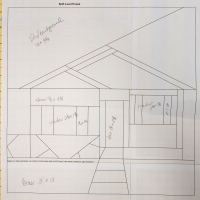Eighty Years Ago in Mexico
Finding clues in the most unlikely of places…
More beautiful textiles arrived from my mother-in-law’s house. She told me that her in-laws had traveled to the West and Mexico on camping vacations every summer, and she thought that’s where these came from.
First we have this gorgeous blanket, which was woven in two narrow panels and then joined down the center. The warp and weft are both wool, about 12 warps to the inch, and about 40 wefts to the inch. (In comparison, a piece that my husband and I bought in Mexico in 1979, has about 12 warps to the inch but only 20 wefts — that makes for a much coarser weave.)
Next we have a smaller piece, maybe more of a throw rug, although it doesn’t look like it was ever used.
Then there are two very coarsely woven “toss rugs,” that were just meant as tourist souvenirs. (There is some color bleeding on these, but the whole house has been flooded several times, so it could be that another textile bled on to these.)
Then we have the pièce de résistance, a beautiful serape, or as they spelled it then, a zarape. This too, has about 12 warps to the inch, but they are fine cotton warps; and there are about 60 wefts to the inch. Most of the weft is wool, but the thin white stripes seem to be cotton.
Of course these are still to be seen in souvenir shops, but with sadly diminished craftsmanship.

Stepped diamond, requiring many small butterflies of weft, instead of one weft crossing the entire piece.
Of course I was curious to find the date of their manufacture. Then in one box of memorabilia, I came across this guidebook:
The book was published in 1937, but did my husband’s grandfather buy it a few years before they went, to plan a good trip? Did he buy it afterward as a souvenir of what they had seen?
Fortunately for me, they marked their intended destinations on two of the maps in the book! So I was guessing they bought the book for research before traveling.
Some interesting notes from the book:
IXMIQUILPAN — two small hotels, hardly possible. Interesting church, very interesting Colonial masonry bridge spanning river, almost a mile from highway back in town. Market on Sundays. Note the Otomie Indians spinning maguey fibre into balls of string as they hurry along the highway.
AFTER LEAVING Colonia Junction, and between Klms. 75 and 70, keep a sharp look three or four points off the port bow for the snow capped peaks of IZTACCIHUATL and POPOCATEPETL, and don’t look for them on the ground but in the Heavens. They are more than eighty miles distant at this point.
If still full of pep, and the day is not too far gone, it is advisable to turn off at Klm. 27 for the pyramids. (You should have at least 3 hrs. of daylight to properly see these monuments.)
SAN JUAN TEOTIHUACAN PYRAMIDS… The archaeological zone comprises several square miles but only 500 acres have been excavated. DON’T miss this! Pass up anything else, or all the rest, but don’t pass this up. Who built them? When? Quien sabe. Your guess may be as good as the next fellow’s. But they are here, and they have been for thousands of years. What a wonderful thing, after all, to be able to motor in a few days from your home over an unsurpassed scenic highway direct to these awe-inspiring, stupendous monuments left by some misterious [sic] race thousands of years ago! Suppose one could motor direct to the pyramids of Egypt without having to ship one’s car across the Atlantic, requiring weeks and costing hundreds and hundreds of dollars? Wouldn’t we think it wonderful? But, even if we could do this still we wouldn’t see anything more wonderful than TEOTIHUACAN.
It goes on for quite a while, but I think you have gotten the flavor of this fabulous guidebook.
Being that this book was published by a souvenir store and cafe, there are several ads scattered through it. Here is one showing their merchandise,
and here is my favorite — it basically says, “Just buy everything at our place here on the border and save yourself a lot of trouble.”

“You can get those curios just as well on your way back, and save the trouble of lugging them all over the country.”
So is that where these rugs and the “zarape” came from? I can’t be sure, but chances are there are more clues tucked into a box somewhere.
And then, in a different box, I found a little brown paper sack, with this tie folded up in it.
I wasn’t fond of the color choice, and as a weaver, I really thought the cloth should have been fulled a little to let the threads bloom and blend with each other into something that looked more like finished cloth, instead of a collection of threads that just happen to be next to each other.
But then! I noticed this small note on the bag.
Spun glass! No wonder it looks like that. I hope it was a short-lived fad because it can’t have been safe for the workers.
So that is our little trip back in time and south of the border. Who knows what will turn up in the next box?




























You are rapidly getting into museum mode! How lucky your in laws have a wonder daughter in law like you……someone who would pay attention to these wonderful acquisitions and take of them in the manner they deserve! Nice to hear the warp and weft counts. Thanks. spun glass? Yipes.
I agree with you about the museum. Except the display information would have to be something like, “These blankets are from Mexico circa 1939 — we think. We started more research into Rio Grande textiles and Zapotec weaving, but then we got sidetracked by Viking cloaks and Jane Austen’s muslins, so that’s as far as we got with this.” 🙂
Wow, I love the serape – what gorgeous colours and the stripes and design go so well together.
Yes, Someone did a lovely job of choosing colors! I am glad you enjoyed it!
I read about weaving fiberglass about 12 years ago. Don’t ask where. My favorite remark was that hand weavers could get hand that hurt.
I bet! Not to mention mesothelioma or something similar!
A tie out of spun glass — I would’ve never guessed that one! Wow!
Me either. I remember liking the look of that glossy white fish filter material when I was a kid, but being told to be sure not to touch it because bits of glass would stick in my skin — I would never have figured out that the tie was made of similar material, it just looks so dull.
As I read and I scrolled, I kept saying, “Wow — wow!” 🙂 The rugs are amazing. Will you use them? I LOVE the guidebook! What fun just to read it.
I think I could use the rugs as table covers or wall hangings. I won’t walk on them, that’s for sure. Where we live it is so sandy and it all gets tracked into the house. Right now they are stacked nicely on a shelf where I see them every day as I walk by, and they can remind me to “do good work!” 🙂
What wonderful bequests! And so in your wheelhouse with all that weaving. Will storage for all these goodies be one of the future gifts?
Actually, we did get 3 nice-sized shelves. They are already full though!
Such wonderful finds.
What wonderful family treasures.
What a beautiful collection.
Thank you, and it’s the best kind — I didn’t have to try to decide among lots of choices, or justify spending any money to myself! 🙂
You find so many wonderful and unusual things on your own and then this marvelous collection just falls into your lap!
I may actually have to stop looking for new ones — my house is stuffed to bursting!
What a treasure trove–and, since you’re a weaver, you can fully appreciate the quality of what you have! My 90-year-old aunt has some Navajo rugs and Mexican serapes she purchased years ago, too–I covet them . . .
I would love to have a Navajo rug! When I first saw the red, black, and white blanket, I thought for a moment it was a Navajo blanket, and I thought, “I won’t be able to keep it, it will be worth too much!” So I was actually kind of glad it was something more common. 🙂
Such beautiful treasures with a wonderful sentimental history. What a true legacy!
So, it looks (on Wikipedia) like fiberglass cloth today is a mixture of plastic and glass. I remember Mother making curtains of fiberglass cloth in the 1950s and commenting that it dulled her scissors badly. But that would have been about the same time we were insulating the house with asbestos, so who noticed? So here’s a question for you: what can you tell me about fiberglass fabric today?
Nothing whatsoever! Do you know something I don’t know? Like, it’s used as insulation in those thin ski garments? Now I am imagining that it is right in front of me and I don’t know about it!
No, I don’t know much about it. A quick search looked like it’s used as a heavy waterproof fabric in marine applications. I have seen my husband patch a fiberglass kayak with a layer of fabric and a layer of glop spread over it with a paint brush. In our living room!
Pingback: TextileTopia, Part Two | Deep in the Heart of Textiles